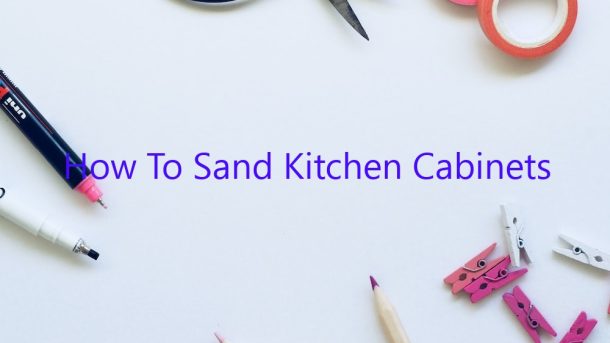Sanding kitchen cabinets is an important step in refinishing them. It prepares the surface for the new finish and gets rid of any imperfections. Here is a guide on how to sand kitchen cabinets:
1. Remove all the hardware from the cabinets.
2. Sand the surface of the cabinets with a medium-grit sandpaper. Start at the top and work your way down. Be careful not to sand too hard or you might damage the surface.
3. If there are any areas that need more attention, use a finer-grit sandpaper to sand them.
4. Wipe the surface of the cabinets with a clean cloth to remove the sanding dust.
5. Apply a coat of primer to the cabinets.
6. Sand the primer with a medium-grit sandpaper.
7. Apply a coat of paint to the cabinets.
8. Sand the paint with a fine-grit sandpaper.
9. Apply a second coat of paint.
10. Sand the second coat of paint with a fine-grit sandpaper.
11. Wipe the surface of the cabinets with a clean cloth to remove the sanding dust.
12. Reattach the hardware to the cabinets.
13. Enjoy your newly sanded kitchen cabinets!”
Contents [hide]
What is the easiest way to sand cabinets?
There are a few ways that you can sand cabinets, but the easiest way is to use an electric sander. You can use a palm sander or an orbital sander. The palm sander is smaller and can get into tight spaces, while the orbital sander has a larger surface area.
If you are using an electric sander, start with the coarsest sandpaper that you have and work your way up to the finer sandpaper. Be sure to sand in the direction of the wood grain.
If you are sanding by hand, start with the coarsest sandpaper and work your way up to the finer sandpaper. Be sure to sand in the direction of the wood grain.
If you are using a chemical stripper, be sure to follow the directions on the label.
Is it better to strip or sand kitchen cabinets?
When it comes to remodeling your kitchen, there are a few options when it comes to the cabinets. One option is to strip the cabinets and start fresh, while another is to sand the cabinets and make them look like new. So, is it better to strip or sand kitchen cabinets?
Stripping the cabinets is a more involved process, but it can give you a completely new look for your kitchen. You’ll need to remove the doors and hardware, and then use a stripping agent to remove the finish. This can be a time-consuming process, but it’s the best way to get a completely new look.
If you decide to sand the cabinets, you’ll need to remove the doors and hardware, and then use a sandpaper to remove the finish. This is a less involved process, but it can still give your cabinets a new look.
So, which option is better? It really depends on your needs and preferences. If you want a completely new look, then stripping the cabinets is the best option. If you’re looking for a quick and easy way to refresh your kitchen, then sanding the cabinets is a better option.
How much do I need to sand my cabinets before painting?
If you’re like most people, you may be wondering how much sanding is necessary before painting your kitchen cabinets. The answer to this question depends on a few factors, such as the age of your cabinets, the type of paint you are using, and your own personal preferences.
In general, most cabinets do not require a lot of sanding before painting. If your cabinets are in good condition and have a smooth surface, you may only need to sand them lightly to remove any dust or debris. However, if your cabinets are older or have a rough surface, you may need to do more sanding to get a smooth finish.
When sanding your cabinets, be sure to use a fine-grit sandpaper, such as 180-grit or 220-grit. This will help to create a smooth finish and prevent the paint from chipping or peeling.
If you’re not sure whether your cabinets need sanding, it’s always best to err on the side of caution and do a little bit more sanding than necessary. This will help ensure that your cabinets are ready for painting and that the paint will adhere properly.
What kind of sander is best for kitchen cabinets?
When it comes to sanding kitchen cabinets, there are a few different types of sanders that can be used. The type of sander that is best for kitchen cabinets will depend on the type of finish that is on the cabinets, as well as the condition of the finish.
If the finish on the cabinets is in good condition, a hand sander can be used. A hand sander is a small sander that is held in the hand. It is a good option for sanding small areas, such as around the hardware on the cabinets.
If the finish on the cabinets is in poor condition, a power sander should be used. A power sander is a larger sander that is powered by an electric motor. It is a good option for sanding large areas, such as the entire surface of the cabinets.
There are a few different types of power sanders that can be used for sanding kitchen cabinets. The most common types of power sanders are belt sanders, orbital sanders, and drum sanders.
Belt sanders are a good option for sanding large areas. They have a large sanding belt that moves back and forth across the surface of the cabinet. This type of sander is good for sanding the finish off of the cabinet, as well as removing any scratches or dings in the finish.
Orbital sanders are a good option for sanding small areas. They have a small sanding pad that moves in a circular motion across the surface of the cabinet. This type of sander is good for sanding the finish off of the cabinet, as well as removing any scratches or dings in the finish.
Drum sanders are a good option for sanding the finish off of the cabinet. They have a large sanding drum that rotates around the surface of the cabinet. This type of sander is good for removing any scratches or dings in the finish.
What kind of sandpaper should I use to sand my kitchen cabinets?
When it comes time to sand your kitchen cabinets, it’s important to use the right type of sandpaper. If you use the wrong type, you could end up damaging your cabinets.
The most common type of sandpaper to use for sanding cabinets is 120-grit sandpaper. This type of sandpaper is coarse enough to remove the finish from your cabinets, but it’s also gentle enough to avoid damaging the wood.
If you’re looking to remove a lot of the finish from your cabinets, you may want to use a higher-grit sandpaper, such as 220-grit or 320-grit. However, be careful not to sand too hard, or you could damage the wood.
If you’re just looking to smooth out the finish on your cabinets, you may want to use a lower-grit sandpaper, such as 60-grit or 80-grit.
When sanding your cabinets, always be sure to use a sanding block. This will help to ensure that you sand the cabinets evenly and avoid damaging them.
Can I sand cabinets by hand?
Can you sand cabinets by hand?
Yes, you can sand cabinets by hand, but it will be a slow process. If your cabinets are in good condition, you may only need to sand them lightly to remove any rough patches or blemishes. If your cabinets are severely damaged, you may need to sand them down to the bare wood before you can apply a new finish.
If you’re going to sand your cabinets by hand, you’ll need to invest in a few pieces of equipment. You’ll need a good quality sandpaper, a sanding block, and a dust mask. You’ll also need to be prepared to work slowly and carefully, to avoid sanding too much or damaging the cabinet surfaces.
If you’re not comfortable sanding your cabinets by hand, you can always hire a professional to do the job for you.
Can you use an orbital sander on cabinets?
Can you use an orbital sander on cabinets?
The short answer is yes, you can use an orbital sander on cabinets. However, there are a few things to keep in mind when sanding cabinets with an orbital sander.
The first thing to keep in mind is that you should use a light touch when sanding cabinets with an orbital sander. You don’t want to apply too much pressure, as this can cause the wood to become too smooth and shiny.
Another thing to keep in mind is that you should always sand in the direction of the wood grain. Sanding against the grain can leave unsightly scratches in the wood.
Finally, be sure to use a fine-grit sandpaper when sanding cabinets with an orbital sander. This will help to achieve a smooth, even finish.




